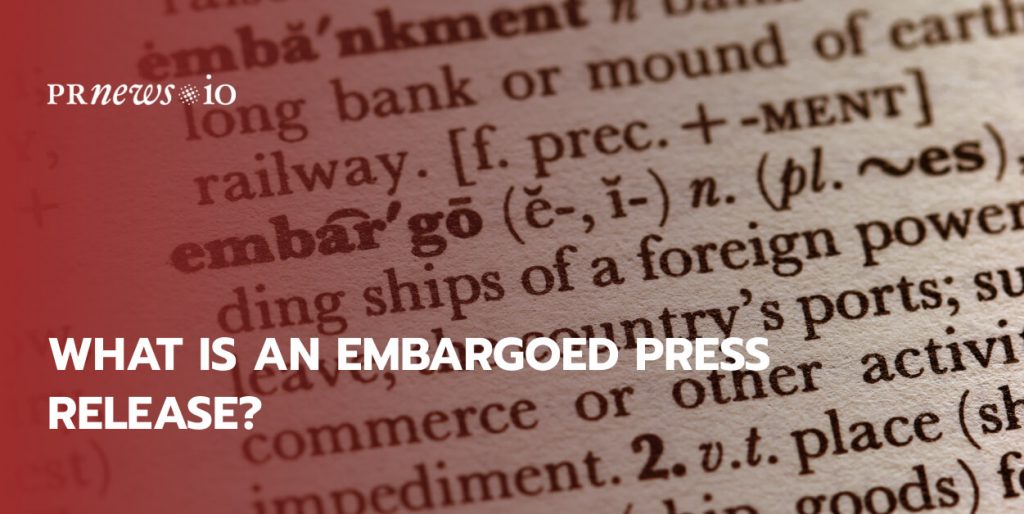
Let’s start with the definition.
Some press releases are sent early and embargoed. For press releases, an embargo means an agreement between the news outlet or media members and the press release writer or company where the news is from not to publish a press release sent in advance.
THE EMBARGOED PRESS RELEASE IS WHEN PRESS RELEASE WRITERS CHOOSE A DATE WHEN THEIR PRESS RELEASE WRITING CAN BE PUBLISHED. THE PRESS RELEASE CAN’T BE PUBLISHED BEFORE THAT DATE.
An example of an embargoed press release would be a copy of presidential speeches sent to the media in advance or products given to members of the media for review before their release dates.
Press release writing services crearte embargoed press releases only a few times because if you always embargo your news, its appeal deteriorates over time. Use an embargo only when you need it.
JUST AS SHIPS WAIT IN PORT TO UNLOAD THEIR CARGO, EMBARGOED STORIES WAIT IN THE QUEUE TO ANNOUNCE THEIR NEWS WHEN THE EMBARGO IS LIFTED.
Gigi Marino from Otter PR
What Does it mean when a press release Is embargoed?
If you look “embargo” up in a dictionary, you will see that it means “ban.” So embargoed = banned.
An embargo means that the organization that issued the press release doesn’t want the news it contains made public until a certain date. Usually, there are marketing reasons for the embargo and its timing. It’s a common practice in public relations.
It means the information (PR release, report, notification, etc.) has been shared with sources, but they are not allowed to make the information public until a specified date and time.
What does “under embargo” mean in the PR world?
Under embargo means that you and the reporter have agreed to keep new information unpublished until an agreed-upon time. With this agreement, the PR team and company executives share new information (like a new product, a new executive hire, etc.) in advance so the journalist has time to write their story without the regular rush, and they can be more thoughtful with their reporting. That being said, agreeing to an embargo doesn’t guarantee that the reporter will actually write a story.
Content Marketing Platform
- 100,000+ media publications;
- get backlinks to your product;
- scale work with content distribution.
Press Releases Writing Tips:
1.
Avoid pushy marketing language. Journalists don’t like that.
2. Make an informative product headline.
3. Make a crisp summary that tells what your product is good for.
4. In the body: describe what the user can do with your product and where your product might have advantages.
5. Describe how users can buy your product and where to get more information.
6. Tell something about you or your company (founded at and when, goals, etc.) at the end of the release.
7. Don’t talk too much about pricing and discounts.
8. Use “Embargo” in your subject line to catch the reporter’s attention.
How should you write an embargoed press release?
You write it just like you would write any other press release, except that you write the embargo date/time clearly across the top.
Don’t send an embargoed press release out too long in advance, but exactly how long depends on the news. Always assume that someone might break the embargo, so do not send it out so early that this would cause problems.
I would also recommend thinking carefully about the need for an embargo. Do you need it? Maybe you will get more coverage by sending your press release out later. I can’t see many people saving it for later unless it is something earthshaking.
An embargo is especially valuable if you wish to give a publication sufficient time to prepare a story before you publicly reveal your news. Most publications like to break the news, so with an embargo, you provide publications with the alternative to have the story ready as quickly as it can be made public.
I’d like to reiterate the point that not all writers honor embargoes. You must reach out to the targeted few that you want to work with and get an agreement before you send them the information.
I find discussing an embargoed press release with a reporter and setting up a briefing with the company before the release date is useful. The release is then sent with the confirmation of the agreed-upon embargo timing as well as the interview time, who at your company will be in the interview (either by phone or in person), etc.
How to send an embargoed press release?
Check this detailed instruction on how to send an embargoed press release provided by Saurav Ahuja, Marketing Specialist at ExcelTrick:
Below is an ideal guideline on how to send an embargoed press release. You need to follow some essential steps:
Determine which person you want to contact.
First, you need to decide to whom you desire to send your embargoed press release.
Select the media outlets.
In the next step, choose the media outlets through which you want to send press releases according to your field.
Gather the important information.
Next, you need to gather all the essential information that is related to your embargoed press release.
Make it more specific.
In the next step, you can enter the email or the name of the person to whom you want to send your press release in order to make it more specific.
Follow the right structure of email.
It is very essential to focus on the accurate structure of the email before sending your embargoed press release. It must include
- At which position you are in your company
- Your belongings
Click on the send option.
At last, ust need to click on the send option and your press release is sent.
PR Experts about Embargo on Press Release
Matias Rodsevich, founder and CEO of PRLab, a PR agency situated in Amsterdam.

It’s any PR professional’s dream to get the client they’re representing featured in a tier 1 media outlet! Think Forbes, Bloomberg, TechCrunch, etc. One way of possibly securing this type of coverage is by pitching exclusively to your dream outlet, while still under embargo. I like to chase an exclusive at least two weeks before the embargoed date is lifted.
This gives you enough time to follow up or to pursue an alternative exclusive opportunity. With an exclusive, I also like to pitch the journalist with an interview opportunity in addition to the press release. We recently landed one of our clients an exclusive with TechCrunch, moments after publication – the press release was shared over 135 times in the news!
The other option is to send out the press release to multiple contacts at least 3 days prior to the embargoed date being lifted. This can be done via a PR tool, like Meltwater. Make sure to clearly state something down the line of “Embargoed for Release Until Sunday, October 7, 2018, at 2 p.m., EDT” – be very specific with dates and times.

Gigi Marino, Account Strategist at Otter PR:
“An embargo is a temporary hold or stay. (The word originates from a 17th-century Spanish embargar, which translates to placing a sanction on ships in port.)
Embargo represents a trust between a news source and journalists and are most often used with peer-reviewed scientific journals that are announcing breakthrough discoveries. Placing an embargo on the news ensures that a significant news story will be reported at the same time and that no one source will scoop another.
To place an embargo on a story, you simply type Embargoed Until Date And Time across the top of the news release. You also should write EMBARGOED in all caps in your subject line.
The purpose of an embargo is to give journalists an adequate amount of time to do solid research and conduct interviews for a story that is introducing new information to the world, such as the naming of a new species, the discovery of black holes, or the Webb Telescope photos that were recently revealed showing never-before-seen cosmic images.
Oftentimes, the lifting of an embargo coincides with a media event at which the news is announced. The journalists who attend will have already had time to do their homework because they were privy to the embargoed press release.
Especially in the digital age, when so much information circulates freely, respecting the embargo is a sacred duty of the Fourth Estate.”

Ashley Willis, Vice President at FischTank PR
An embargo outreach strategy has numerous benefits for client announcements, namely, the advance notice journalists need to review the news, conduct interviews, and prepare a story ahead of the formal announcement date. Before sending an embargoed press release, it’s best to start with a high-level pitch that teases the news with a few high-level details and asks the reporter to agree to the embargo. With confirmation in hand, PR professionals can feel confident in distributing the embargoed release. Any advance distribution of the press release should note the embargo at the top of the page, with the date and time of distribution.
Once a reporter has the embargoed press release, the real work begins. The follow-up to gather feedback on the news and interest in pursuing the story is absolutely necessary to move towards coverage for the announcement. It’s during this time that PR reps can gather insights from the media in order to make any needed adjustments to strategy and messaging to ensure a successful announcement day.

Ron Boling, Account Director at Jonathan Marder and Company:
Every time I send an embargoed release, I use the below steps to start.
Make sure your client knows that there is always a chance that journalists can publish the information before the embargo date. There is always a small risk involved with date-sensitive information.
Firstly, approach journalists that you have a relationship with and are likely to honor the embargo.
Increase the number of contacts incrementally and based on the acceptances and declines you receive. It’s always risky to go too wide too soon, as journalists do not have to honor the embargo unless specifically agreed upon.

JJ Lee, Digital PR Executive at Digital Funnel
The top tip for sending an embargoed press release is to just avoid sending the release out too early, especially when it comes to very, very big announcements unless everything is absolutely confirmed and set in stone. You should only send out an embargoed release around 2-3 days before the official announcement is made, by doing this you’re giving journalists and outlets adequate time to prepare their story and have it ready for publication in and around the same time.
In this modern age, embargoes are relatively risky, such is the speed at which information and stories can be published on the internet that your information needs to be watertight and you need to be overly particular with your restrictions. For example, if your release is embargoed until Friday, you need to state that it’s embargoed until 7 am, GMT, and the date – otherwise you’re going to have publications in different time zones publishing the information ahead of others and if you’re supplementing this release with a newswire push, there’s a chance you may actually lose coverage as the story becomes oversaturated.

Jonathan Saeidian, Founder/CEO of Brenton Way
If you’re looking to send an embargoed press release, there are a few unique ways you can go about it.
One option is to send the embargoed press release as a PDF attachment with a password-protection feature. When sending, include the password in the body of the email so that journalists can access it on the day of the embargo lift.
Use an online service or tool like PRNEWS.IO that allows you to embargo your press release until a specific date and time. This way, you can control when your release goes out and be sure it will have the maximum impact.
Follow up after sending – Once you’ve sent out your embargoed press release, follow up with a phone call or email to ensure the recipient understands when they can publish the information.

Michelle Garrett, Writer/Public Relations Consultant at Garrett PR
One mistake I see PR people make with embargoed press releases is just slapping the word “embargo” at the top of the pitch or press release -without first asking the reporter if they honor embargoes. The reporter must first agree – or the embargo is meaningless.
I think they work best when a reporter and a PR pro have an established relationship. Then, the PR pro might offer a reporter an embargo so they can begin to work on a story that will be published when the press release or news goes live.

Kristen Shea, President of Tribe Builder Media
Create your embargo strategy around the relationship you have with the press.
For journalists you already have an established relationship with, share the press release with the disclaimer that it is under an embargo. Be sure to notate the date and time the embargo ends; you will want to ensure this is formatted to stand out (red, highlighted, bold, etc.).
For journalists, you have yet to establish a relationship, ensure they honor embargoes before pitching them. Some places to check for this information include the journalist’s social media, database profiles, and individual columns or pages on a publication’s website. If they do not honor embargoes, do not pitch them the press release until the day of the announcement after it goes live.
Propose the embargo before sharing it. Depending on the nature of the press release and relationship with the journalist, consider holding off on sending it. For sensitive materials, it might make more sense to have the journalist agree to the embargo before sharing the full press release.
The initial proposal needs to reveal enough to show the journalist it’s applicable to their coverage, but also intrigue them enough to agree to the embargo to receive the release.
An example: I hope this finds you well. I see that you recently covered [insert funding announcement coverage of interest], and I’d like to put another on your radar. I’m working with an eCommerce company that will soon be announcing a $50 million funding round. I would be happy to share additional details if you agree to an embargo through [date/time].
Don’t stagger embargo times. This is a surefire way to agitate journalists. There are circumstances where a journalist will require an exclusive, which will impact the visibility and overall performance of the press release. Sending out an embargo to a list of vetted journalists means reporters can accept (or pass) the story as they see fit, and the press release has a better chance of placement with multiple publications and outlets.
Embargoed Press Release FAQ
?Why do science journals embargo press releases?
Marketing and practicality. They don’t want researchers to claim that their work will be published until it actually is, and they want to focus any possible public attention on the one day of publication, to maximize the chance of the work (…and the name of the journal) reaching a wide audience. As an aside, I find it irritating that most embargoes break the day before publication, so I keep reading of new work in Google News or Eureka Alert, and cannot access the paper at that moment (and good luck to me remembering to check into it tomorrow!).





